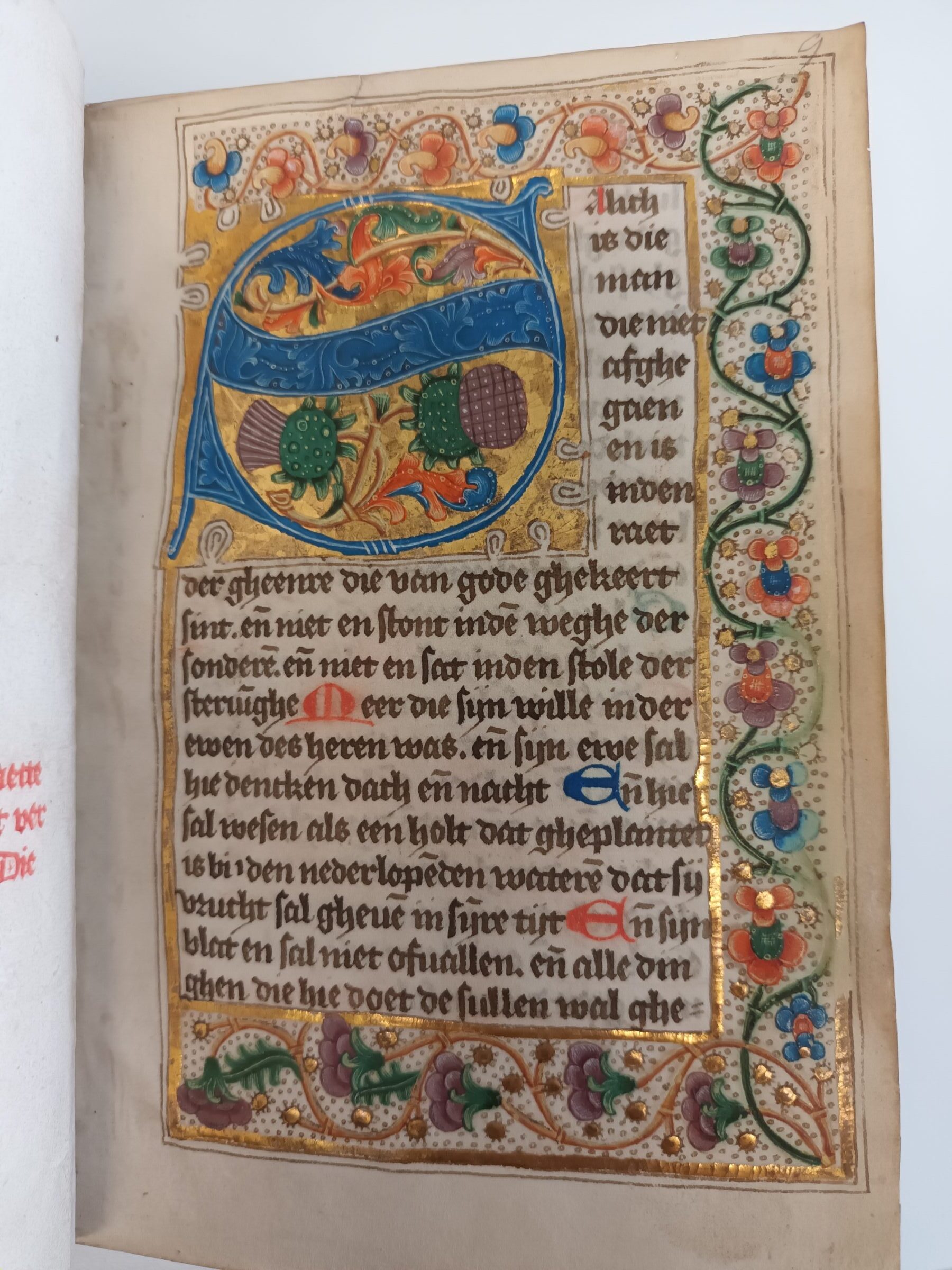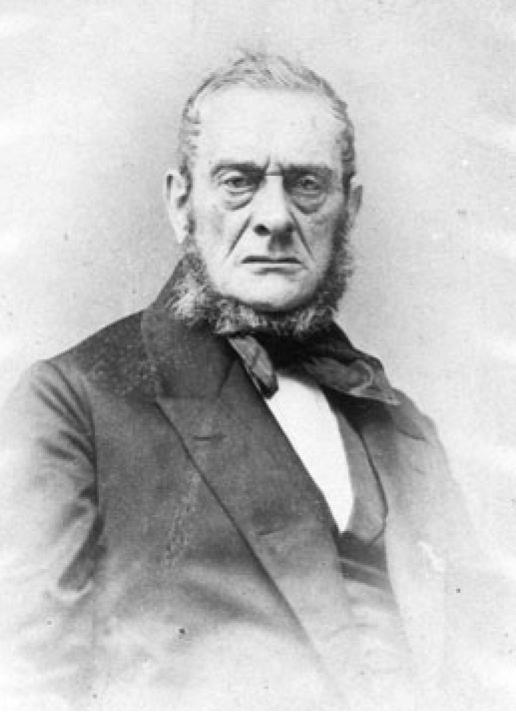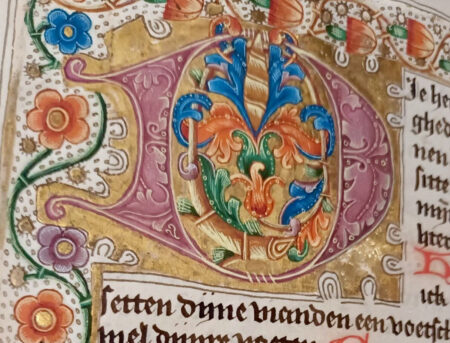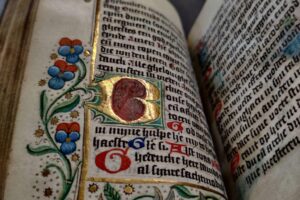The Hinckaertshuis on the Oude Kijk in ‘t Jatstraat is one of the oldest houses in the city of Groningen. It was built in 1290. For centuries, it was inhabited by prominent families. Through one of these, the Hinckaertshuis has a connection with a handwritten psalter that was made around 1500 in a monastery near the city.
This psalter was transcribed in the monastery of Selwerd, which was located outside the city of Groningen from 1216 until its demolition in 1601. This monastery belonged to the Benedictine Order. From 1486 onwards, only nuns lived in the monastery and they copied an impressive amount of manuscripts, including various books of tides. A book of tidesis a book with prayers used by laymen. The prayers were read at set times (tides) of the day. In addition to prayers, books of tides often also contain an ecclesiastical calendar with feast days and anniversaries. Many books of tides were written in Latin, but the nuns at Selwerd also copied texts in Middle Dutch. Our psalter contains 150 psalms from the Old Testament, translated by Geert Groote and Johan Scutken. We know Groote as a theologian, as a reformer in the Catholic church, and as an advocate of preaching in the vernacular. Johan Scutken was an author and translator, and a lay brother in the monastery of Windesheim near Zwolle.



This psalter is illuminated (decorated) in a style that is characteristic of the Groningen region. This style of decoration can be found in many books that were created in monasteries in this northern region. In addition to coloured capital letters, this handwritten psalter contains two lavishly illustrated pages for Psalm 1 and Psalm 109. Around the capital letters S (Salich is die man) and D (De Here is), we can see colourful blue, orange, and green flowers. The edges of the pages around the text frame are decorated with smaller, coloured flowers, little balls, and stems in gold and silver. This psalter is made of paper, but it also contains three sheets of parchment. We don’t know who copied or illuminated this psalter.
Back to the Hinckaertshuis. Its location and first owners are inextricably linked to the Mepschen Gasthuis next door, the name of which is connected to Evert de Mepsche. This hospital on the Oude Kijk in ‘t Jatstraat 4 was established in 1479 by Syerd Lewe. It still exists today. A tablet on the facade mentions the name of the woman who founded it: dit Gasthuis heeft Gestigtet Die Ed: Er: vrouw Syerd d’Mepsche (this hospital was founded by the right honourable lady Syerd d’Mepsche). She was not a ‘real’ De Mepsche, but the occupants of the Hinckaertshuis in the 17th century chose to put this prominent family name on the facade. The name De Mepsche first appears in connection to Lewe with Wemele Lewe, a niece of Syerd and also her heir, as Syerd died childless. Wemele married Roelof de Mepsche in the 1460s and that is how this rich and prominent family ended up owning the Hinckaertshuis. Roelof de Mepsche also had a connection with Selwerd: he was a bailiff there. Roelof’s son, Johan de Mepsche, may have been the first De Mepsche to live in the Hinckaertshuis. One of Johan’s sons was the namesake and grandfather of ‘our’ Evert Junior, the owner of this psalter.

We know this psalter was owned by Evert de Mepsche the Younger, because he stated so in the book himself, which was not uncommon at the time. At the beginning of the book he wrote: Evert de Mepsche der Jonger anno 93 (Evert de Mepsche the Younger in the year 93). Evert either bought this psalter or received it as a gift in 1593. We do not know who owned the psalter before Evert. There is a text in different handwriting directly following Evert’s words: ad filium suum Gerardum D. Mepsche transtulit. Anno 1612 morte patris, i.e. ‘passed on to his son Gerard de Mepsche. In the year 1612 by the death of (his) father’. Thanks to this, we know that, after Evert’s death in 1612, the psalter was owned by his son Gerard. We do not know whether it remained in the De Mepsche family after Gerard.

However, this psalter’s journey did not stop at Evert de Mepsche and his son Gerard. Under their names an ex libris has been pasted in the book with the following text: J. Baart de la Faille, Med. Prof. Groningen. This Jacob Baart de la Faille was a 19th-century physician and professor at the University of Groningen who was at the centre of the medical world in Groningen from 1826 onwards, contributing to, and participating in, numerous societal activities. He worked as a physician in the city’s hospital for the poor, the Institute of the Deaf, and the Red Orphanage. From 1832 until 1867 he was a professor of obstetrics and paediatrics at the University, and he taught clinical lessons, including to midwives in the city. Unlike the prayers that Evert de Mepsche wrote at the back of the psalter in his own handwriting, Baart de la Faille left no traces of his ownership other than his ex libris. The University of Groningen Library bought the psalter in 1868 after Baart de la Faille’s death, when his sizeable book collection was put up for auction.
Author: Frida van Til
With thanks to Redmer Alma




